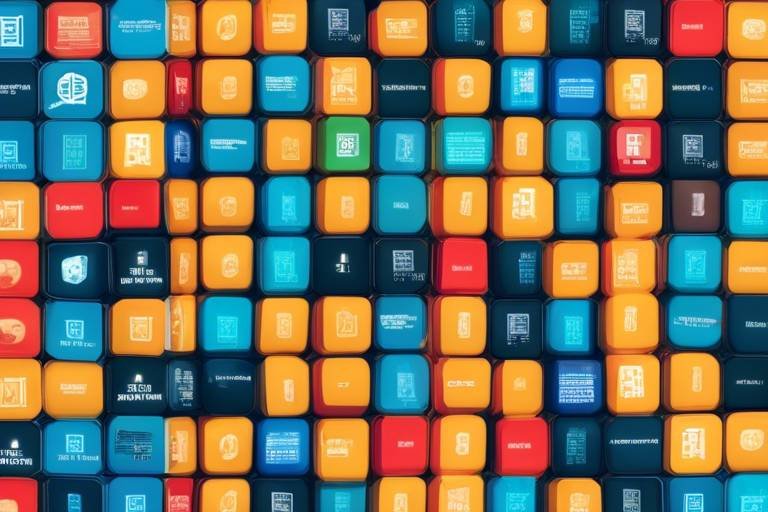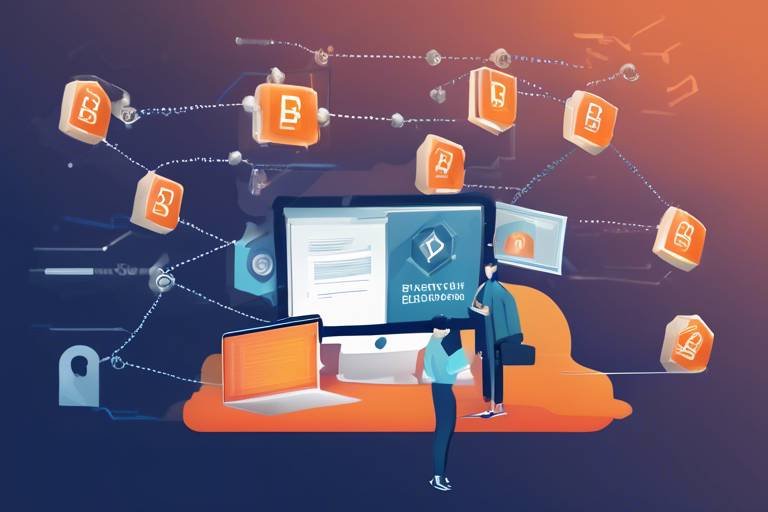Understanding the Role of Blockchain in Disaster Management
In an era where natural disasters seem to occur with increasing frequency and intensity, the need for effective disaster management has never been more critical. Imagine a world where emergency responses are not only swift but also transparent and trustworthy. Enter blockchain technology, a game-changer that promises to revolutionize how we handle crises. By leveraging the unique features of blockchain, such as decentralization and immutability, we can enhance coordination among various stakeholders, streamline communication, and ensure that resources are allocated efficiently.
At its core, blockchain is a distributed ledger technology that records transactions across multiple computers in such a way that the registered information cannot be altered retroactively. This characteristic is particularly beneficial in emergency scenarios, where the integrity of data can make a significant difference in the outcome of disaster response efforts. When we talk about disaster management, we are referring to a complex web of interactions among government agencies, non-profit organizations, and local communities. Blockchain can serve as the backbone of this network, fostering a collaborative environment where information flows freely and securely.
Furthermore, the transparency that blockchain offers can significantly reduce the chances of fraud and corruption during disaster relief operations. Think about it: when funds are flowing in from various sources to support recovery efforts, how can we ensure that every dollar is spent appropriately? With blockchain, every transaction is recorded and visible to all relevant parties, creating a level of accountability that is often missing in traditional systems. This not only builds trust among stakeholders but also empowers communities to take an active role in their recovery.
Additionally, blockchain can facilitate real-time data sharing, which is crucial during emergencies. Imagine a scenario where first responders need immediate access to information about available resources, shelters, or even the status of affected populations. With blockchain, they can access up-to-date information without the delays often associated with bureaucratic processes. This capability can mean the difference between life and death in critical situations.
As we delve deeper into this topic, we will explore the various benefits of blockchain in emergency response, including its potential to automate processes through smart contracts, provide real-time tracking of resources, and enhance overall transparency. By understanding these elements, we can appreciate how blockchain technology is not just a buzzword but a powerful tool that can reshape disaster management for the better.
- What is blockchain technology? - Blockchain is a decentralized digital ledger that records transactions across multiple computers, ensuring data integrity and transparency.
- How can blockchain improve disaster management? - By facilitating real-time data sharing, enhancing coordination among agencies, and reducing opportunities for fraud.
- What are smart contracts? - Smart contracts are self-executing contracts with the terms of the agreement directly written into code, allowing for automated responses in emergencies.
- What challenges does blockchain face in disaster management? - Key challenges include scalability, interoperability with existing systems, and regulatory concerns.

The Basics of Blockchain Technology
Blockchain technology is often seen as a complex and somewhat intimidating concept, but at its core, it is quite simple. Imagine a digital ledger that records transactions in a way that is both secure and transparent. Each transaction is grouped into a block, and these blocks are linked together in a chronological order, forming a chain. This is where the term "blockchain" comes from. The beauty of blockchain lies in its decentralized nature, meaning that no single entity has control over the entire chain. Instead, it operates on a network of computers, or nodes, that work together to validate and record transactions.
One of the key features of blockchain technology is its immutability. Once a block is added to the chain, it cannot be altered or deleted. This is akin to carving a message into stone; it remains unchanged and can be viewed by anyone. This characteristic is crucial in disaster management, where maintaining accurate and unalterable records is vital for accountability and trust. Additionally, the use of cryptographic techniques ensures that the data stored within the blockchain is secure and protected from unauthorized access.
Another important aspect of blockchain is its transparency. All transactions are visible to participants within the network, which fosters a sense of accountability. Imagine a community where every donation made for disaster relief can be tracked and verified—this level of transparency can significantly reduce the potential for fraud and corruption. Furthermore, blockchain operates on consensus mechanisms, meaning that all nodes must agree on the validity of a transaction before it is added to the chain. This collective agreement enhances the reliability of the data and builds trust among stakeholders.
To better understand how blockchain functions, consider the following key components:
- Blocks: Each block contains a list of transactions, a timestamp, and a reference to the previous block.
- Nodes: These are the computers that participate in the blockchain network, validating and storing the data.
- Consensus Mechanisms: Methods used to achieve agreement on the validity of transactions (e.g., Proof of Work, Proof of Stake).
- Smart Contracts: Self-executing contracts with the terms of the agreement directly written into code, allowing for automated processes.
In summary, understanding the basics of blockchain technology is essential for appreciating its potential applications in disaster management. Its decentralized, immutable, and transparent nature can revolutionize how we respond to emergencies, ensuring that data integrity and trust are maintained throughout the process. As we explore the benefits of blockchain in emergency response, it becomes clear that this technology is not just a buzzword; it has the potential to transform the landscape of disaster management.

Benefits of Blockchain in Emergency Response
When we think about disasters, whether natural or man-made, the chaos that ensues can often leave people feeling helpless. But what if there was a way to bring some order to that chaos? Enter blockchain technology, a powerful tool that can significantly enhance emergency response efforts. Imagine a scenario where information is shared in real-time, coordination among agencies is seamless, and trust is built into every transaction. Sounds like a dream, right? Well, with blockchain, this dream can become a reality.
One of the standout features of blockchain is its ability to facilitate real-time data sharing. During a disaster, timely information is crucial. Whether it’s knowing where to send aid or understanding the needs of affected communities, having access to accurate data can make all the difference. Blockchain allows multiple stakeholders, from government agencies to non-profits, to access the same information concurrently. This not only speeds up response times but also reduces the chances of miscommunication. Can you imagine the difference this could make when lives are on the line?
Moreover, blockchain enhances coordination among various agencies involved in disaster management. When multiple organizations are working together, it’s essential that everyone is on the same page. Blockchain’s decentralized nature means that no single entity has control over the data, promoting a collaborative environment. Each agency can see updates in real-time, ensuring that resources are allocated efficiently and effectively. This level of coordination can lead to quicker, more effective responses, ultimately saving lives.
Another critical benefit is the enhancement of trust among stakeholders. In emergency situations, transparency is key. Blockchain technology provides an immutable record of transactions, meaning that once data is entered, it cannot be altered or deleted. This feature builds confidence among agencies and the public alike. When people can see exactly how resources are being distributed and where aid is going, it fosters a sense of accountability that is often lacking in traditional systems. Trust is not just a nice-to-have; it’s a necessity in disaster management.
To illustrate these benefits further, let’s consider a hypothetical scenario. Imagine a major earthquake hits a city. Emergency services, NGOs, and government agencies need to come together quickly to provide relief. With blockchain, they can share information about affected areas, track supplies, and coordinate their efforts without the risk of data manipulation. This means that help can reach those in need faster and more efficiently. It’s like having a well-oiled machine working tirelessly to restore normalcy in the face of disaster.
Additionally, blockchain can help in tracking the distribution of aid and resources. With the ability to monitor every transaction in real-time, stakeholders can ensure that supplies are reaching their intended destinations. This transparency not only minimizes the risk of corruption but also builds confidence in the system. Communities are more likely to trust that help is on the way when they can see it happening in real-time.
In summary, the benefits of implementing blockchain in emergency response are profound. From real-time data sharing and improved coordination to enhanced trust and transparency, blockchain has the potential to revolutionize how we respond to disasters. As we continue to face challenges in disaster management, embracing innovative technologies like blockchain could be the key to saving lives and restoring communities.
- What is blockchain technology? Blockchain is a decentralized digital ledger that records transactions across many computers securely and transparently.
- How does blockchain improve disaster response? It allows for real-time data sharing, enhances coordination among agencies, and builds trust through transparency.
- Can blockchain prevent corruption in disaster management? Yes, its immutable nature ensures that data cannot be altered, promoting accountability and reducing the risk of corruption.
- What are smart contracts? Smart contracts are self-executing contracts with the terms of the agreement directly written into code, automating processes based on specific conditions.

Decentralization and Data Integrity
When we talk about decentralization in the context of blockchain, we're diving into a concept that fundamentally shifts how we think about data management and security. Unlike traditional systems where a single entity holds all the keys to the data kingdom, blockchain operates on a decentralized model. This means that no one party has complete control over the data. Imagine a library where every book is not just in one place but is instead duplicated across many locations. If one library burns down, the information is still available in others. This is the essence of decentralization.
In disaster management, this decentralization is crucial. It enhances data integrity by ensuring that information is not only secure but also reliable. Since data is stored across multiple nodes, it becomes incredibly difficult for malicious actors to alter or delete information without being detected. Each transaction or piece of data added to the blockchain is time-stamped and linked to previous entries, creating a transparent and unchangeable record. This is akin to having a digital fingerprint for every piece of information, making it virtually impossible to forge.
Moreover, the decentralized nature of blockchain promotes trust among various stakeholders involved in disaster management. When multiple agencies—be it government bodies, NGOs, or local communities—can access the same unalterable data in real-time, it fosters a sense of accountability. Everyone can see what has been done, what resources are available, and where aid is needed most. This transparency can significantly reduce the chances of fraud and mismanagement, which are often rampant in disaster scenarios.
To illustrate the importance of decentralization and data integrity in disaster management, let's consider a scenario:
| Feature | Centralized System | Decentralized Blockchain System |
|---|---|---|
| Data Control | Single entity controls data | Data is distributed across multiple nodes |
| Data Security | Vulnerable to hacks and data loss | Highly secure due to multiple validations |
| Transparency | Limited visibility for stakeholders | Full visibility and access for all parties |
| Trust | Requires trust in a single entity | Trust is built through transparency and consensus |
In conclusion, the decentralized approach of blockchain not only enhances data integrity but also builds a framework of trust among all stakeholders involved in disaster management. As we navigate through emergencies, having a reliable, transparent, and secure system in place is invaluable. It empowers organizations to respond swiftly and effectively, ensuring that help reaches those who need it most without the fear of data manipulation or loss.
- What is blockchain technology? Blockchain is a decentralized digital ledger that records transactions across many computers securely and transparently.
- How does decentralization improve disaster management? It reduces the risk of data manipulation and enhances trust among stakeholders by providing a transparent view of all data.
- Can blockchain be integrated with existing systems? Yes, interoperability is key, and strategies can be developed to ensure blockchain works alongside traditional systems.
- What are smart contracts? Smart contracts are self-executing contracts with the terms of the agreement directly written into code, allowing for automated responses in emergencies.

Smart Contracts for Automated Response
Imagine a world where disaster response is not just reactive but also proactive, where systems automatically spring into action the moment a crisis hits. This is where smart contracts come into play. Smart contracts are self-executing contracts with the terms of the agreement directly written into code. They operate on the blockchain, which means they are decentralized, transparent, and tamper-proof. In the context of disaster management, these contracts can automate processes and responses, ensuring that aid and resources are deployed swiftly and efficiently.
For instance, consider a natural disaster like a hurricane. As soon as a weather alert is issued, a smart contract can automatically trigger a series of actions. This could include notifying emergency services, releasing funds for relief efforts, or even deploying drones to assess damage. The beauty of this technology lies in its ability to eliminate delays caused by bureaucratic processes. Instead of waiting for manual approvals, the smart contract executes actions based on predefined conditions, thus expediting the entire response effort.
One of the key advantages of using smart contracts in disaster scenarios is their ability to enhance coordination among different agencies. In emergencies, multiple organizations often need to collaborate, from government bodies to NGOs and private sector partners. Smart contracts can streamline communication and ensure that everyone is on the same page. For example, if a certain threshold of donations is reached, a smart contract could automatically allocate funds to specific relief efforts, ensuring that resources are directed where they are needed most.
Moreover, smart contracts can also help in maintaining transparency and accountability. By recording all transactions on the blockchain, stakeholders can track how funds are allocated and used. This transparency is crucial in disaster management, where trust is paramount. When people see that their donations are being used effectively, it not only builds confidence but also encourages further support.
To illustrate the potential of smart contracts in disaster management, let’s take a look at a hypothetical scenario:
| Event | Smart Contract Action | Outcome |
|---|---|---|
| Earthquake Alert Issued | Trigger emergency fund release | Immediate financial support for rescue teams |
| Donation Threshold Met | Allocate funds to local NGOs | Faster distribution of aid |
| Resource Allocation Request | Notify logistics teams | Efficient mobilization of resources |
As we can see, the integration of smart contracts into disaster response not only speeds up the process but also ensures that actions are taken based on real-time data and predefined criteria. This level of automation and efficiency can make a significant difference in saving lives and providing timely assistance during critical situations.
In conclusion, smart contracts represent a revolutionary step forward in disaster management. By automating responses and improving coordination among various stakeholders, they can transform how we react to emergencies. As we continue to explore the potential of blockchain technology, it’s clear that smart contracts will play a pivotal role in shaping the future of disaster response.
- What are smart contracts? Smart contracts are self-executing contracts with the terms directly written into code, operating on a blockchain.
- How do smart contracts enhance disaster response? They automate processes, trigger actions based on specific conditions, and improve coordination among agencies.
- Are smart contracts secure? Yes, they are secure as they operate on a decentralized blockchain, making them tamper-proof and transparent.
- Can smart contracts help in resource allocation during disasters? Absolutely! They can automatically allocate resources based on real-time data and predefined conditions.

Real-Time Tracking and Transparency
In the chaotic aftermath of a disaster, one of the most critical aspects is ensuring that resources are distributed effectively and efficiently. This is where real-time tracking and transparency come into play, and blockchain technology shines like a beacon of hope. Imagine a world where every bit of aid—be it food, medical supplies, or shelter—is tracked in real-time, allowing organizations to see exactly where resources are at any given moment. This isn’t just a dream; it’s a reality that blockchain can help create.
Blockchain's inherent characteristics allow for a transparent ledger that is accessible to all stakeholders involved in disaster management. This transparency means that every transaction is recorded and can be verified by anyone with access to the blockchain. For instance, if an organization sends a shipment of water to a disaster-stricken area, the details of that shipment—such as the quantity, time of dispatch, and recipient—are logged on the blockchain. This creates a trustworthy trail that can be audited by various parties, including government agencies, NGOs, and the affected communities themselves.
Furthermore, the ability to track resources in real-time can significantly reduce the risk of corruption and mismanagement. When everyone can see where aid is going and how it is being used, it becomes much harder for individuals or organizations to siphon off resources for personal gain. This level of accountability is crucial, especially in the wake of disasters where every second counts and every resource is precious.
To illustrate the impact of real-time tracking and transparency, let's consider a hypothetical scenario:
| Resource Type | Quantity Sent | Destination | Time of Dispatch | Status |
|---|---|---|---|---|
| Water Bottles | 5000 | Community Center A | 10:00 AM | In Transit |
| First Aid Kits | 200 | Hospital B | 10:15 AM | Delivered |
| Tents | 100 | Relief Camp C | 10:30 AM | In Transit |
This table could be generated and updated in real-time on a blockchain platform, allowing everyone involved to see the current status of resources. It’s like having a live scoreboard during a game—everyone knows what’s happening, and there’s no room for confusion or misinformation.
In conclusion, the integration of real-time tracking and transparency through blockchain technology can revolutionize disaster management. It not only enhances coordination among different agencies but also fosters a culture of accountability and trust. As we move forward, embracing these technological advancements will be essential to ensure that aid reaches those who need it most, when they need it the most.
- How does blockchain ensure transparency in disaster management?
Blockchain records every transaction in a decentralized ledger, making it accessible for all stakeholders to verify and audit.
- Can blockchain technology help in real-time resource allocation?
Yes, blockchain allows for real-time tracking of resources, enabling better allocation and distribution during emergencies.
- What are the main challenges of implementing blockchain in disaster management?
Challenges include scalability, interoperability with existing systems, and regulatory concerns.

Case Studies of Blockchain in Action
When it comes to disaster management, the application of blockchain technology is not just a theoretical concept; it's a reality that has been tested and proven in various scenarios around the globe. One of the standout examples is the use of blockchain in the aftermath of natural disasters, where traditional systems often falter under pressure. Let's dive into some real-world case studies that showcase how blockchain has made a significant impact in these critical situations.
One noteworthy instance occurred during the 2017 hurricane season in the Caribbean, where Hurricane Maria devastated Puerto Rico. In the wake of the disaster, the Puerto Rico Blockchain Coalition implemented a blockchain-based system to manage aid distribution. This system allowed for real-time tracking of resources, ensuring that supplies reached those in need without the usual bureaucratic delays. By utilizing a decentralized ledger, they were able to maintain transparency, which significantly reduced the chances of corruption and misallocation of resources.
Another compelling case study comes from the United Nations World Food Programme (WFP), which has been at the forefront of utilizing blockchain technology for humanitarian aid. The WFP launched a project called Building Blocks, where they used blockchain to deliver food assistance to refugees in Jordan. This initiative allowed refugees to receive food vouchers via a secure blockchain network, enabling them to purchase food from local vendors. The results were astounding: not only did it streamline the distribution process, but it also empowered the local economy by ensuring that funds were spent within the community.
In addition to these examples, there are numerous pilot projects and initiatives globally that have explored blockchain's potential in disaster response. For instance, in the Philippines, where typhoons are a regular occurrence, a blockchain-based platform was developed to enhance the resilience of communities. This platform allows local governments and NGOs to collaborate more effectively, sharing vital information about risk assessments and resource availability in real-time. By fostering better communication and coordination, blockchain has proven to be a game-changer in preparing for and responding to disasters.
To provide a clearer picture of the impact of these initiatives, here's a brief overview of some key outcomes from these case studies:
| Case Study | Location | Key Outcomes |
|---|---|---|
| Puerto Rico Blockchain Coalition | Puerto Rico | Improved aid distribution, reduced corruption |
| Building Blocks | Jordan | Empowered local economy, streamlined food assistance |
| Philippines Disaster Response | Philippines | Enhanced community resilience, improved coordination |
These case studies highlight the transformative potential of blockchain technology in disaster management. By fostering transparency, improving coordination, and ensuring accountability, blockchain is not just a buzzword; it’s a powerful tool that can revolutionize how we respond to emergencies. The lessons learned from these initiatives provide invaluable insights for future implementations, paving the way for more efficient and effective disaster response strategies.
Q1: How does blockchain improve transparency in disaster management?
A1: Blockchain creates a decentralized ledger that records all transactions and data in real-time. This transparency ensures that all stakeholders can track resources and aid distribution, reducing the potential for corruption and mismanagement.
Q2: Are there any limitations to using blockchain in disaster management?
A2: Yes, some limitations include scalability challenges during large-scale disasters, interoperability with existing systems, and regulatory concerns that need to be addressed for effective implementation.
Q3: Can blockchain be used for other types of emergencies beyond natural disasters?
A3: Absolutely! Blockchain can be applied in various emergency situations, including public health crises, humanitarian aid, and even in managing supply chains during pandemics.

Challenges and Limitations of Blockchain
While the potential of blockchain technology in disaster management is enormous, it is essential to recognize that it is not a panacea. Like any innovative solution, blockchain comes with its own set of challenges and limitations that can hinder its widespread adoption. One of the most pressing issues is scalability. During large-scale disasters, the volume of transactions can surge dramatically, overwhelming the blockchain network. This can lead to delays in processing critical information, which could be detrimental in emergency situations where every second counts.
Another significant challenge is interoperability. For blockchain to be effective in disaster management, it must work seamlessly with existing systems and technologies. Many agencies still rely on traditional databases and communication methods, which may not be compatible with blockchain solutions. This lack of integration can create silos of information, making it difficult for stakeholders to access and share vital data during emergencies.
Moreover, there are regulatory concerns that need to be addressed. The legal landscape surrounding blockchain technology is still evolving, and many jurisdictions lack clear guidelines on how to implement it in disaster management. This uncertainty can deter organizations from investing in blockchain solutions, fearing potential legal repercussions. Additionally, the decentralized nature of blockchain raises questions about accountability and governance, which are critical in disaster situations.
Despite these challenges, there are ongoing efforts to overcome these limitations. For instance, researchers and developers are actively working on improving blockchain scalability through various techniques, such as sharding and layer-2 solutions. These innovations aim to enhance the network's capacity to handle a higher volume of transactions without sacrificing speed or security.
Furthermore, initiatives focused on interoperability are gaining traction. By creating standardized protocols and frameworks, stakeholders can ensure that different blockchain systems can communicate and share data effectively. This will not only streamline operations but also foster collaboration among various agencies involved in disaster management.
In summary, while blockchain technology holds great promise for enhancing disaster management efforts, it is not without its challenges. By addressing scalability, interoperability, and regulatory concerns, stakeholders can unlock the full potential of blockchain, paving the way for more efficient and effective emergency response strategies.
- What is blockchain? Blockchain is a decentralized digital ledger technology that records transactions across multiple computers securely and transparently.
- How can blockchain improve disaster management? Blockchain enhances disaster management by providing real-time data sharing, improving coordination among agencies, and ensuring data integrity.
- What are the main challenges of using blockchain in disaster management? The main challenges include scalability, interoperability with existing systems, and regulatory concerns.
- Can blockchain be integrated with current disaster management systems? Yes, with the development of standardized protocols, blockchain can be integrated with existing systems to enhance efficiency.
- What are smart contracts? Smart contracts are self-executing contracts with the terms of the agreement directly written into code, allowing for automated responses during emergencies.

Addressing Scalability Issues
When it comes to implementing blockchain technology in disaster management, one of the most pressing concerns is scalability. Imagine a situation where a major earthquake strikes a densely populated city. The influx of data from numerous sources—government agencies, NGOs, and volunteers—can overwhelm any system, especially if it's not designed to handle such a massive load. This is where scalability becomes crucial. It’s not just about having a robust system; it’s about ensuring that the system can grow and adapt in real-time to meet the needs of a crisis.
To address these scalability issues, several strategies can be employed. First, the choice of blockchain network plays a significant role. For instance, utilizing layer 2 solutions can enhance transaction speeds and reduce costs. These solutions operate on top of the main blockchain, allowing for faster processing of transactions without compromising security. Another approach is the use of sharding, where the blockchain is divided into smaller, manageable pieces, enabling parallel processing of transactions. This means that instead of every node in the network needing to process every single transaction, they can work on smaller sections, significantly increasing efficiency.
Moreover, the integration of off-chain solutions can also help. By processing certain transactions outside the blockchain while still maintaining a connection to the main chain, we can alleviate some of the burdens on the network. This is particularly useful for data-intensive operations that don't require the full security of the blockchain for every single transaction. For example, during a disaster, real-time data about resource allocation and distribution can be handled off-chain, while critical transactions like fund transfers remain on-chain.
However, it’s essential to ensure that these solutions are not only effective but also interoperable with existing systems. This means that as we implement these scalable solutions, we must also consider how they will interact with traditional disaster management systems. A seamless integration can enhance the overall efficiency of the response efforts. It’s like fitting pieces of a puzzle together; every piece must align perfectly for the bigger picture to emerge.
In summary, addressing scalability issues in blockchain for disaster management is not just about enhancing technology; it’s about ensuring that we can respond effectively to crises. By leveraging layer 2 solutions, sharding, off-chain processing, and ensuring interoperability, we can create a resilient system capable of supporting disaster management efforts when they are needed the most. The question remains: are we ready to embrace these innovations and integrate them into our emergency response frameworks?
- What is blockchain scalability?
Scalability in blockchain refers to the ability of the network to handle a growing amount of work or its potential to accommodate growth. - How can off-chain solutions help in disaster management?
Off-chain solutions allow certain transactions to be processed outside the blockchain, reducing the load on the network and improving response times. - What are layer 2 solutions?
Layer 2 solutions are protocols built on top of existing blockchains to enhance their scalability and efficiency. - Why is interoperability important?
Interoperability ensures that new blockchain solutions can work seamlessly with existing disaster management systems, enhancing overall effectiveness.

Interoperability with Existing Systems
When it comes to implementing blockchain technology in disaster management, one of the most critical factors is interoperability. This refers to the ability of different systems and organizations to work together seamlessly. Imagine a scenario where multiple agencies—such as local governments, non-profit organizations, and international relief efforts—are all trying to coordinate their responses during a major disaster. If these entities are using different systems that cannot communicate with each other, the result can be chaos. Information may be duplicated, vital resources could be misallocated, and ultimately, lives may be at stake.
The integration of blockchain technology into existing disaster management frameworks can significantly enhance this interoperability. By providing a shared, decentralized ledger, blockchain allows all parties involved to access the same data in real time. This means that whether it's the local fire department, a humanitarian organization, or a government agency, everyone can see the same information regarding resource availability, affected areas, and ongoing relief efforts. Such transparency not only fosters trust among various stakeholders but also ensures that everyone is on the same page, reducing the likelihood of miscommunication.
To achieve effective interoperability, several key strategies can be employed:
- Standardization of Protocols: Establishing common standards for data formats and communication protocols can facilitate smoother interactions between blockchain systems and traditional databases.
- API Development: Creating Application Programming Interfaces (APIs) that allow blockchain systems to communicate with existing software can bridge the gap between old and new technologies.
- Training and Education: Ensuring that all stakeholders are trained in blockchain technology and its applications can help mitigate resistance to change and promote a culture of collaboration.
Moreover, pilot programs can be a valuable approach to test interoperability on a smaller scale before a full rollout. By collaborating with a few agencies to implement blockchain solutions, stakeholders can identify potential issues and address them proactively. This iterative process not only builds confidence in the technology but also allows for the refinement of strategies to ensure seamless integration with existing systems.
In conclusion, while the potential of blockchain in disaster management is immense, its success hinges on effective interoperability with existing systems. By fostering collaboration, standardization, and training, we can create a more resilient and responsive disaster management framework that ultimately saves lives and resources.
- What is interoperability in the context of blockchain? Interoperability refers to the ability of different blockchain systems and traditional databases to communicate and work together effectively.
- Why is interoperability important for disaster management? It ensures that various agencies can share real-time information, reducing miscommunication and improving coordination during emergencies.
- How can agencies achieve interoperability? Through standardization of protocols, API development, and training for stakeholders.
- What are the challenges of integrating blockchain with existing systems? Challenges include resistance to change, the complexity of existing systems, and the need for technical expertise.
Frequently Asked Questions
- What is blockchain technology?
Blockchain technology is a decentralized digital ledger that records transactions across multiple computers in a way that the registered transactions cannot be altered retroactively. This ensures security, transparency, and trust among participants without the need for a central authority.
- How can blockchain improve disaster management?
Blockchain can enhance disaster management by facilitating real-time data sharing, improving coordination among agencies, and ensuring data integrity. By providing a transparent and immutable record of transactions, it fosters trust among stakeholders involved in emergency response efforts.
- What are smart contracts, and how do they work in emergencies?
Smart contracts are self-executing contracts with the terms of the agreement directly written into code. In emergencies, they can automate processes, such as triggering aid distribution when certain conditions are met, thus expediting the response time and reducing human error.
- Can blockchain help with resource tracking during disasters?
Absolutely! Blockchain allows for real-time tracking of resources and aid distribution, ensuring that all parties have access to the same information. This transparency helps improve accountability and reduces the chances of corruption in disaster management.
- What challenges does blockchain face in disaster management?
Despite its potential, blockchain faces several challenges, including scalability issues during large-scale disasters, interoperability with existing systems, and regulatory concerns that can hinder its adoption in emergency situations.
- How can scalability issues be addressed in blockchain applications?
Scalability can be addressed by implementing solutions like off-chain transactions, sharding, or layer-2 protocols that allow for increased transaction throughput while maintaining the security and integrity of the blockchain.
- Why is interoperability important for blockchain in disaster management?
Interoperability is crucial because it allows blockchain systems to communicate with existing disaster management tools and technologies. This integration ensures that blockchain can be effectively utilized alongside traditional systems, maximizing its benefits in real-world scenarios.



















